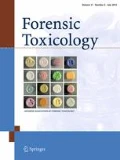Abstract
Metabolism of cannabinol (CBN) was studied in vitro using hepatic microsomes from human livers. The metabolites formed were analyzed by thinlayer chromatography (TLC) and identified by gas chromatography-mass spectrometry as their trimethylsilyl derivatives. 11-Hydroxy-CBN, the major metabolite, was detected together with a smaller amount of another mono-hydroxylated metabolite. The minor metabolite was identified as 8-hydroxy-CBN, after comparing its Rf value by TLC, retention time by GC, and the mass spectrum with those of the authentic compound. 8-Hydroxy-CBN was confirmed to be a new metabolite of CBN formed by human hepatic microsomes.
References
Christensen HD, Freudenthal RI, Gidley JT, Rosenfeld R, Boegli G, Testino L, Brine DR, Pitt CG, Wall ME (1971) Activity of δ8-and δ9-tetrahydrocannabiol and related compounds in the mouse. Science 172:165–167
Perez-Reyes M, Timmons MC, Davis KH, Wall ME (1973) A comparison of the pharmacological activity in man of intravenously administered δ9-tetrahydrocannabinol, cannabinol, and cannabidiol. Experientia 29:1368–1369
Watanabe K, Yamaki E, Yamamoto I, Yoshimura H (1979) A colorimetric method for the determination of cannabinoids with Fast Bule BB salt. Eisei Kagaku 25:321–326
Widman M, Nilsson IM, Nilsson JLG, Agurell S, Leander K (1971) Metabolism of cannabis. IX. Cannabinol: structure of a major metabolite formed in rat liver. Life Sci 10:157–162
Widman M, Dahmen J, Leander K, Petersson K (1975) In vitro metabolism of cannabinol in rat and rabbit liver. Acta Pharm Suec 12:385–392
Yisak Y, Widman M, Lindgren J-E, Agurell S (1977) Neutral in vivo metabolites of cannabinol isolated from rat faeces. J Pharm Pharmacol 29:487–490
Harvey DJ, Martin BR, Paton WDM (1980) Identification of in vivo liver metabolites of δ1-tetrahydrocannabinol, cannabidiol, and cannabinol produced by the guinea pig. J Pharm Pharmacol 32:267–271
Yamamoto I, Kuzuoka K, Watanabe K, Narimatsu S, Yoshimura H (1988) sMetabolic formation and pharmacological effects of 11-hydroxycannabinol, an active metabolite of cannabinol. In: Chesher G, Consroe P, Musty R (eds) Marihuana: an international research report. National Campaign Against Drug Abuse, monograph series No. 7. Australian Government Printing Office, Canberra, pp 135–140
Brown NK, Harvey DJ (1990) In vitro metabolism of cannabinol in rat, mouse, rabbit, guinea pig, hamster, gerbil and cat. Eur J Drug Metabol Pharmacokinet 15:253–258
Watanabe K, Matsunaga T, Yamamoto I, Yoshimura H (1995) Involvement of CYP2C in the metabolism of cannabinoids by human hepatic microsomes from an old woman. Biol Pharm Bull 18:1138–1141
Aramaki H, Tomiyasu N, Yoshimura H, Tsukamoto H (1968) Forensic chemical study on marihuana. I. A detection method of the principal constituents by thin-layer and gas chromatographies. Chem Pharm Bull 16:822–826
Inayama S, Sawa A, Hosoya E (1974) The oxidation of δ1-and δ6-tetrahydrocannabinol with selenium dioxide. Chem Pharm Bull 22:1519–1525
Ben-Zvi Z, Mechoulam R, Burstein S (1970) Synthesis of δ1-and δ1(6)-tetrahydrocannabinol metabolites. Tetrahedron Lett 51:4495–4497
Ohlsson A, Agurell S, Leander K, Dahmen J, Edery H, Porath G, Levy S, Mechoulam R (1979) Synthesis and psychotropic activity of side chain hydroxylated δ6-tetrahydrocannabinol metabolite. Acta Pharm Suec 16:21–33
Watanabe K, Arai M, Narimatsu S, Yamamoto I, Yoshimura H (1986) Effect of repeated administration of 11-hydroxy-δ8-tetrahydrocannabinol, an active metabolite of δ8-tetrahydrocannabinol, on the hepatic microsomal drugmetabolizing enzyme system of mice. Biochem Pharmacol 35:1861–1865
Watanabe K, Yamamoto I, Oguri K, Yoshimura H (1980) Identification and determination of 11-oxo-δ8-tetrahydrocannabinol as an intermediate metabolite of δ8-tetrahydrocannabinol in the mouse brain and liver. J Pharm Dyn 3:686–691
Lowry OH, Rosebrough NJ, Farr AL, Randall RJ (1951) Protein measurement with the Folin phenol reagent. J Biol Chem 193:265–275
Jerina DM, Daly JW (1974) Arene oxide: a new aspect in drug metabolism. Science 185:573–582
Yamamoto I, Watanabe K, Kuzuoka K, Narimatsu S, Yoshimura H (1987) The pharmacological activity of cannabinol and its major metabolite, 11-hydroxycannabinol. Chem Pharm Bull 35:2144–2147
Author information
Authors and Affiliations
Corresponding author
Rights and permissions
About this article
Cite this article
Watanabe, K., Yamaori, S., Funahashi, T. et al. 8-Hydroxycannabinol: a new metabolite of cannabinol formed by human hepatic microsomes. Forensic Toxicol 24, 80–82 (2006). https://doi.org/10.1007/s11419-006-0016-0
Received:
Accepted:
Published:
Issue Date:
DOI: https://doi.org/10.1007/s11419-006-0016-0

